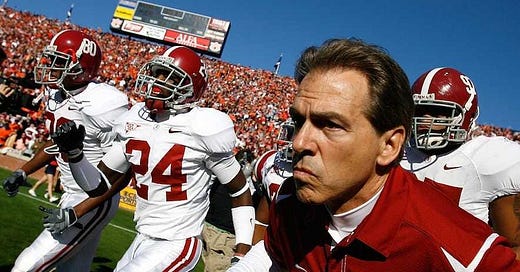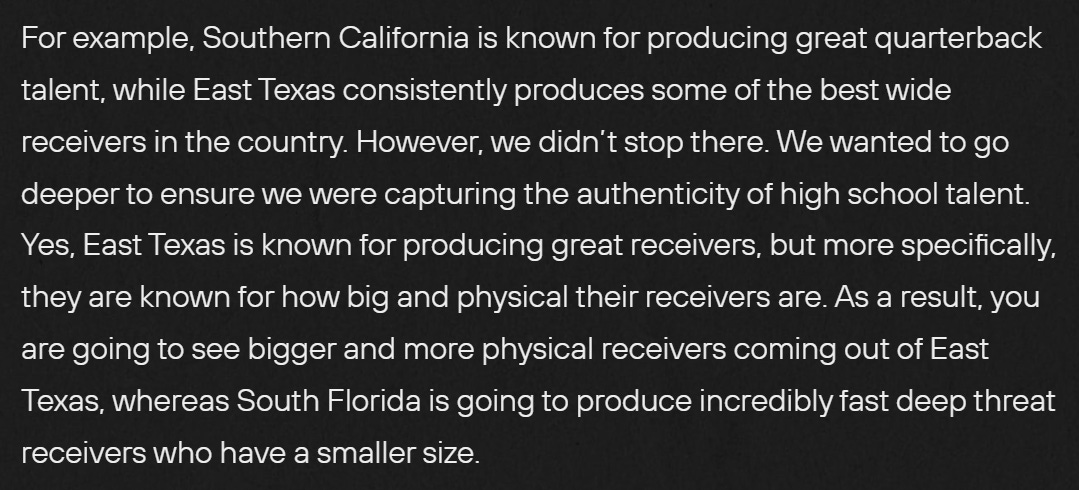I've always dreamed about being a coach. My highest level of professional experience came on the sidelines of a 3-on-3 basketball tournament against fellow writers at my college newspaper. (Spoiler alert: we ... did not win.)
It's the type of dream that I know will never come to fruition (unless you're an athletic director reading this, in which case - hire me!). But I've never stopped chasing the dream, anyway, with many long hours spent on loading screens, studying box scores, and chasing down auto-generated athletes on the virtual recruiting trail.
And I can already feel my summer schedule slipping away ahead of the release of College Football 2025.
There are so many exciting modes to tackle when this game comes out on July 19. Our Jeremy Vernon broke down what to know about Road to Glory, while Brandon Scobey and Dedrick Hendrix each offered their takes on the best narrative paths and most popular teams that people will chase in dynasty mode.
Even something like Play Now should be as rich of an experience as ever with the game's overhauled home-field advantage and various new game mechanics that help make this arguably the most-hyped sports video game of this generation.
Of course, all eyes have long been on dynasty mode, which was the crown jewel of the original NCAA Football games and will likely drive record-setting sales for this month's release. And EA Sports finally delivered with a deep dive on the beloved mode last week:
You can read about every single new change to the mode in the Dynasty Deep Dive, an 85-page blog post (I'm not kidding) that doubles as a love letter to the inner coach in all of us. For those who don't have an hour to read a manifesto - or those of you who, like me, can't consume enough content about it - we have you covered.
We offered our own deep dive into recruiting shortly after the blog post dropped. Here's what stood out to me about the full coaching experience in College Football 2025:
Create the coach of your dreams
Within the first few paragraphs of the dynasty deep dive, the developers laid out three core pillars that anchored the dynasty mode experience: "build your coach," build your program" and "deliver the world of college football."
That first part is key, and it's an area I feel so many sports games have been lacking in for years. There's a strong crossover between fans of RPGs and dynasty modes in sports games, and the character creation and progression from the best games in the former category leave so many of us wanting more from the latter.
Clearly, the developers at EA Sports recognize that: they even reference "traditional RPG classes" when describing the game's new coach archetypes and abilities system, which should feel familiar to anyone who's ever played an RPG or even some of the top sports career modes.
Every coach will start with a base archetype in one of three categories – recruiting, motivation and scheme – that will set the early foundation for your skill tree as a coach, though there are 11 different archetypes in total. As you succeed in games, recruiting and the draft, you’ll earn coach XP to level up and earn coach points to unlock unique coach abilities within each archetype.
What stands out to me with this system is the way EA Sports is layering in agency and consequence. The game features “more than 50 coach abilities” with up to four tiers each, and the progressive costs for each tier will force you to make decisions about which paths to pursue. Some archetypes have prerequisites to unlock that require not only coach points but also an objective, such as landing two top-five recruiting classes to become an elite recruiter.
Adding to that complexity is the fact that most abilities are broken down by position group, forcing you to prioritize what type of coach you’ll be from the very beginning. This is exactly what most sports games have been lacking over the years: non-linear pathways to success that respect what I might enjoy most about my own coaching experience (though we’ll surely learn the “meta coaching build” soon enough).
Just like in the old NCAA Football games, you can choose to start out as a head coach or a coordinator. That was a wonderful idea at the time – and it’s since been replicated – but the coordinator route felt more like a narrative curtailment than an actual feature, as it functioned almost identically to being a head coach but with less functionality.
It’s hard to imagine it’ll feel that way this year with how granular your coach creation and progression will be. While it doesn’t appear we’ll have the option to play as a position coach (maybe next year?), you can focus all your skill points on one side of the ball or even one specific skill group and add legitimate value to your program in a non-HC capacity. That’s such a change from how it felt before, when being a coordinator felt more like a prequel to the real thing than a unique experience.
You can also edit your coach's progression speed with five different options (presumably very slow to very fast), which is an awesome touch to allow various pacing to your journey through the coaching ranks. That also makes it more tenable to go the hardcore coordinator route for those of us who enjoy the journey less traveled. Or you can become the next Nick Saban in just a few seasons. It’s ultimately your experience, and it feels like the developers truly respect that.
Moving up the ladder
One of the most beloved features of the old NCAA Football games makes a return in 2025 with the “coaching carousel” - an offseason period of chaos that shapes the overall trajectory of your dynasty each and every year.
It’s not the novel idea it once was when it came out over a decade ago, but the developers have added enough wrinkles to pique my interest. Now, the coaching carousel will last five weeks starting the week after conference championships, which is just the perfect dose of mayhem for teams preparing for their bowl games. You'll even be able to coach your team for one last time before leaving all your beloved players behind. (As they say, "it's in the game.")
Incredibly, schools now evaluate candidates based on their specific fit with the program itself. Each school will have a preferred coaching archetype (like Louisville wanting a strategist in the image above), and schools will also target coaches with specific schemes or recruiting pipelines. Not only does this ensure that schools have more appropriate schematic and cultural fits for their program - which is a major plus on its own - but it adds such a compelling layer of strategy to your own coaching path.
When I talk about character creation mattering in a sports video game, this is it. If I create an up-tempo offensive genius with a strong recruiting pipeline all along the West Coast, you can bet I'm angling to eventually replace Dan Lanning at Oregon. For once, the game will actually notice, and there’s no better setting for that level of nuance than college football.
The other side of the coaching carousel is managing your staff as a head coach. As mentioned before, coordinators will have their own individual skill trees – that you as head coach can’t control, thank goodness – which can stack with or complement the abilities of your head coach. It’s yet another reminder that your coaching build really does matter, and you’ll have so much flexibility and autonomy to build the proper support staff around your coach.
Add that to the “talent tree” system where players are more likely to transfer if their favorite coach bolts, and suddenly there's more at stake than ever in the coaching carousel.
A new frontier in recruiting
OK, obviously, recruiting is a huge part of coaching. But we’ve already gone in-depth on that element of dynasty mode (and will continue to do so), so I’ll just highlight some of my favorite aspects as they relate to your coaching journey.
The thing that stood out most to me from the deep dive is the incredible level of detail and granularity in the recruiting process. Every school has 14 different “grades” that align with the motivations for recruits. Every recruit has three ideal pitch motivations that matter most to securing their commitment, and there’s a chance one could be a “dealbreaker” – an unwavering need that follows a player throughout their career.
Fail to meet the minimum requirement for a recruit’s top desire, and they’ll lock you out of the process entirely. Fall below that grade after securing their commitment, and they’ll be more likely to transfer to a school that ultimately meets their needs.
I absolutely love everything about this. I’m struck by how it humanizes each recruit (a stated goal of the development team) and adds flavor to the entire recruiting pool. If a player wants to play close to home and I’m on the other side of the country, I don’t want to be considered. If they want to get drafted and my school has never won a bowl game, you should probably look elsewhere!
Obviously, recruit preferences aren’t a new concept, but I’m encouraged by how the development team is taking a simple concept and building in so much depth with more than a dozen pitch grades and various ways to sway recruits’ interests and motivations.
When paired with the advanced UI and intuitive staged approach to recruiting, I can already feel the sleepless nights approaching as “just one more week” turns into an entire recruiting cycle.
There’s one last thing I want to touch on, and it might be my new favorite feature in any sports video game ever: redesigned recruiting pipelines.
Pipelines are clearly a fundamental aspect of any college sports game, and the developers have blown them open by ditching the old “state-by-state” model for a new hyper-local focus on recruiting. The new game will still have 50 pipelines, but some will encompass entire states (or multiple) with others focusing on key recruiting hotbeds like South Florida and Metro Atlanta.
As mentioned earlier, schools will place a premium on coaches whose pipelines align with their own. Just think about how dramatically that will reshape the way you create your coach and advance their career. Establishing a strong recruiting presence in the areas your preferred school covets – even if it’s not in their own state – will land you on their radar, just as it would in real life.
Just read this section from the deep dive about how the team approached geographic regions in recruiting:
That is insane. It wasn't long ago that a feature like that would only exist on message boards with devoted fans ultimately writing it off as a pipe dream. Now it's coming to our very consoles in little over a week, and my own coaching dreams feel as alive as ever.
C Jackson Cowart is a Featured Columnist for Four Verts: An EA Sports College Football 25 Substack. He's an award-winning sports writer, reporter, and editor with a decade of experience in the industry with previous stops including ESPN, Forbes, theScore, Action Network, Sporting News, and Sportsbook Review. He's also an avid video game player who still talks about the time he threw a perfect game in Triple-A in MLB: The Show. You can follow him on Twitter (X) @CJacksonCowart.












